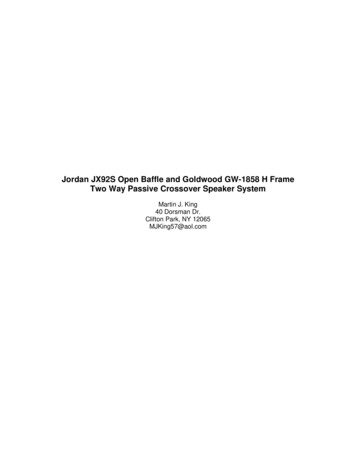
Transcription
As originally published in the IPC APEX EXPO Conference Proceedings.Electrical Testing of Passive ComponentsTodd L Kolmodin Gardien Services USAManfred Ludwig Gardien Services ChinaHoward Carpenter Gardien Services USAIntroductionSubstrates have become more critical with regard to pitch and density in today’s designs with challenges for passivecomponents in terms of surface placement. This negates the opportunity for high speed, high cost components to beplaced on the surfaces of the PCB. With this the capacitance and resistive components have to be embedded into thedesign. This has been accomplished with the advent of buried capacitance cores and buried resistors. Unfortunatelythis has caused some challenges to the ET Test Centers/Labs in the ability to effectively test these buried passivecomponents. Processes have had to change and adapt to these new technologies. The paper will discuss what thesenew technologies are and how the Electrical Test arena has adapted to provide accurate testing of the buried resistorsand accommodate the buried capacitive cores to not receive false errors from the Grid Testers and Flying Probes.ResistorsIn the past pull-up, terminating and voltage dividing resistors have been placed on the surface of the PCB. Earlyapplications were standard carbon resistors placed on the board utilizing Plated through Holes.Figure 1: Carbon Resistors (as noted by their color rings)As can be seen in Figure 1 the standard carbon resistor took up a lot of space on the PCB. You will also notice inthe photo that Capacitors are also stealing valuable space from the surface topography. As time progressed SMTTechnology was introduced and the older, bulky standard carbon resistor was replaced by the newer SMT packages(Figure 2).
Figure 2: Surface Mount ResistorsThis was a very popular innovation to the industry as now the surface footprint was drastically reduced and thetopography on the surface of the PCB was now open to accommodate more active components which reduced theoverall size of the PCB but also allowed the complexity of the designs to grow. No longer was a PTH as needed forthe resistor so this allowed the multilayer to expand its capabilities on the inner layers to provide not only an overallsmaller PCB but a more powerful final product.These technologies albeit reduced the footprint of the PCB but by no means could we have the smartphones andTablets and many of the day-to-day devices we know and rely on today. Further it would be impossible to use theolder technologies of yesteryear to power the mammoth internet infrastructure that we take for granted today.Something still had to change. The next evolution was to hide the passive components completely from the surfaceof the PCB and allow the needed high power footprints of the BGAs, Micro BGAs and HDI components. As of nowthese high speed components have challenges to be buried in the board design due to their size and the need for heatdissipation. However the passive components could be. The buried passive component allowed the ability toprovide the pull-up, terminating, current limiting and voltage dividing properties without taking needed real-estatefrom the surfaces of the PCB.There have been many options of the buried resistor. This spans from the carbon ink screened resistor through tothin film resistor conductor material.
Figure 3: Thin Film Embedded ResistorThis technology allows the ability to develop a buried resistor by the use of a resistive core laminated into the PCBitself. By etching away a “Square” or a multiple of them a specific resistance can be achieved. There is no “hard”component any longer.Figure 4: Thin Film Resistance CalculationBut this now provides a unique challenge to the Electrical Test arena as they need to test this product with the buriedsignature and also certify the board to the End User specification, be it IPC Class I, II, III or 3/A. Many times theseresistors are chained in series or used in parallel and this does not allow the conventional Electrical Test Machine toprovide a “Pass.” Trying to test these buried resistors by conventional means only results in a “Fail”, as usually theresistance is higher than the IPC Class requirement. Further, care has to be maintained to not compromise theresistor itself due to excess current applied.When we are testing the buried resistor we must take into account the power dissipation of the given resistor. As weknow if we apply too much current to a resistor and overload its power dissipation rating, the resistor will burn.
Testing ResistorsElectrical testing is required to validate the correct resistor values and also identify faulty or out-of-toleranceresistors. It is recommended that Electrical test be performed on both the inner layer and the final board so that if aresistor is faulty at the inner layer stage it can be scrapped prior to any further value-add to the PCB. Netlist testingmust be used as a learn and compare type of test which cannot validate the expected value. Most of today’sCAD/CAM systems have the ability to output tester data with inclusion of the buried passives. The IPC-356A dataformat provides the inclusion of the buried passives. What must be included are all the resistor locations or testpoints, the expected value and the upper and lower tolerance values. There are a few different options for testing theresistors. This can be the use of a Universal Grid Tester (Bed-of-Nails), a Flying Probe Tester or the use of aManual Measurement System. In the end the accuracy of the readings will depend on the accuracy of the meteringsystem being used, the amount of copper between the test probes and the actual resistor, contact resistance and theresistance of the probes and leads. Most important is that the measurement current should not exceed the currentcarrying capacity of the resistor. This could lead to permanent damage of the resistor.For most automated test systems the following guidelines should be applied:1.Input the power rating (watts) of the resistor, if this feature is supported by the test system2.Limit the test current used to 20mAA Flying Probe (or Grid Test) machine basically contains a high speed ohmmeter that allows rapid gathering ofresistance values for nets on the PCB.Figure 5: Resistor Measurement with Current LimitingOnce the resistor value is known the machine will make the necessary tests to the resistors and catalogue the results.It will compare the expected value with the read value (compensating for the allowed tolerances) and internally logthe resistor net as Pass or Fail. Once the entire test of the PCB is complete a report ticket will be printed stating thePCB passed or failed and will identify all resistors that failed in addition to the standard Continuity Test results.Many machines of today can also supply a report of all the resistor values read for the given PCB for statisticalprocess monitoring.
Protecting the ResistorsWhen testing the resistors via a Flying Probe care must be taken to limit the voltage/current drive to themeasurement. Flying Probes have two methodologies when taking measurements, Constant Current and ConstantVoltage. Depending on the design of the Flying Probe you have could cause some concerns. If the BR record wasprovided in the raw netlist the machine should make the appropriate determinations of how to best test the resistor.If the system is solely Constant Current source (grid/prober) it should be able to automatically detect if the testparameters are in range. If the system has Constant Voltage capability then it can auto-range itself to the appropriatepower level. A Constant Current system is only limited by its internal supply voltage. With a Constant Currentscenario the actual power or “Wattage” is not monitored and can be detrimental to the UUT. The Constant Currentmethod is far too restrictive for the range of resistors that are in use today. These measurements should be done in aConstant Voltage mode. In this scenario the current is based on the actual resistance read and not the calculated oranticipated value. In this scenario it is a simple calculation of E*I where E is the voltage applied and I is the current.In a Constant Voltage scenario the resistance is only needed to calculate the required voltage of the source. Themeasurement parameters are constructed using the E P/I formula where E Voltage, P Power and I Current. Themeasurement is taken at the calculated E and the resultant I is measured and calculated in Ohms.CapacitorsJust as with the buried resistors, capacitance can also be embedded into the PCB. This is done by the use of acapacitive core material laminated into the PCB. This removes the need for surface decoupling capacitors and aswith the removal of some of the surface resistors allows more space on the surface of the PCB and allows the overallsize to be reduced.
Figure 6: Various Capacitor evolution, ceramic paper, SMT and buried capacitive cores
However this introduces a challenge with Electrical Test. With the buried capacitance in the PCB false “shorts” canbe reported by the tester. The standard Electrical Test for shorts applies a voltage (primary point) and reads forcurrent leakage on adjacent nets in the case of the Flying Probe or any nets in the case of the bed-of-nails grid testmachine. A specific threshold is set on the machine so that nets to one another must have a minimum resistancebetween them or a failure is reported. For example, IPC-9252A Class III specifies greater than or equal to 10MOhms. This measurement is taken very quickly and due to the capacitive charge time the test machine may reportthis momentary “leak” as a false short.TestingGrid TestUnfortunately one finds that many of the older Grid Test Machines have no solution for negating this capacitivecharge component. Newer machines have the ability to delay the measurement for a specified time to allow for thecapacitive charge to stabilize before the reading is taken. This is relatively transparent to the operator. Once the testis initiated the Continuity Test is performed as normal. When the isolation (shorts) test begins the machine appliesthe test voltage to the PCB and then waits during the input delay time before taking measurements. This allows thecapacitive core to charge and stabilize. The end result is a “Pass” rather than a false error reported.Flying ProbeThese machines have the same dilemma when testing PCBs with buried capacitance. Flying Probes do not bydefault test every net to every net for shorts as the Grid Test machines do. Flying Probes use what is calledAdjacency Testing for shorts. One reference probe is set on a net and the other probes measure for leakage inadjacent nets. This window is defined during the CAM process. As with the Grid Test machines the same chargetime variable is introduced and can cause false errors to be reported. Earlier software packages driving thesemachines did not have an accurate way to delay the reading and they were not able to provide a “Pass” to theproduct which required a manual verification of the error and a human decision made to whether the board was goodor not. This was the same with the older Grid Test machines.Some newer software packages for the Flying Probers did in fact incorporate delay timers to combat the capacitivecharge. However these timers were applied to the entire test which would slow the machine down. Although it wasa solution it adds time to the overall test on the Flying Probe. Another known software package for the Flying Probeintroduced a bit of AI to the test routine which actually monitors for this charging variable. This allows the machineto run at full speed until it detects a possible short. It then falls into a delay routine and takes multiple measurementsof the suspect net to determine if it is a capacitive charging variable or an actual short. If the resistance between thetwo nets charges and a stable resistance reading is obtained within the test parameter threshold the machine will passthe network and move on. If the leakage continues in excess of the timer measurement threshold a true short isindicated and the net will be flagged as a failure. This advantage allows the overall test time of the PCB to remainoptimal rather than slowing down every measurement reading resulting in lost velocity and throughput.ConclusionsAs technology grows and PCB sizes shrink the demand for embedded technologies will only grow. Many end-usersare designing embedded passives into their products and the Electrical Test community is expected to provide thetest solutions for these new powerful designs. The use of buried resistors is increasing and care must be taken toidentify these components during the ET CAM process so that the test machines are aware of them and do notoverpower them with standard test parameters. For the design community that uses the buried core technology themanufacturers of this material have always recommended using the largest configuration for the buried resistor asfeasible. As noted previously the “square” should be as large as feasible to provide the required resistance whilealso maintaining the optimum power dissipation level to ensure long life and stability.Buried capacitance has been around for a long time but is also increasing. The ability for Electrical Test toaccurately test this type of product is crucial. Accurately identifying and allowing the buried capacitance component,results in improved throughput and delivery. It also reduces unnecessary delays, troubleshooting and unfortunatescrap of product that is actually good.
of the PCB and allow the needed high power footprints of the BGAs, Micro BGAs and HDI components. As of now these high speed components have challenges to be buried in the board design due to their size and the need for heat dissipation. However the passive components could be. The buried passive component allowed the ability to










